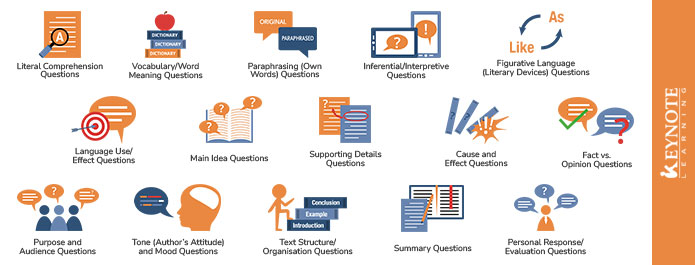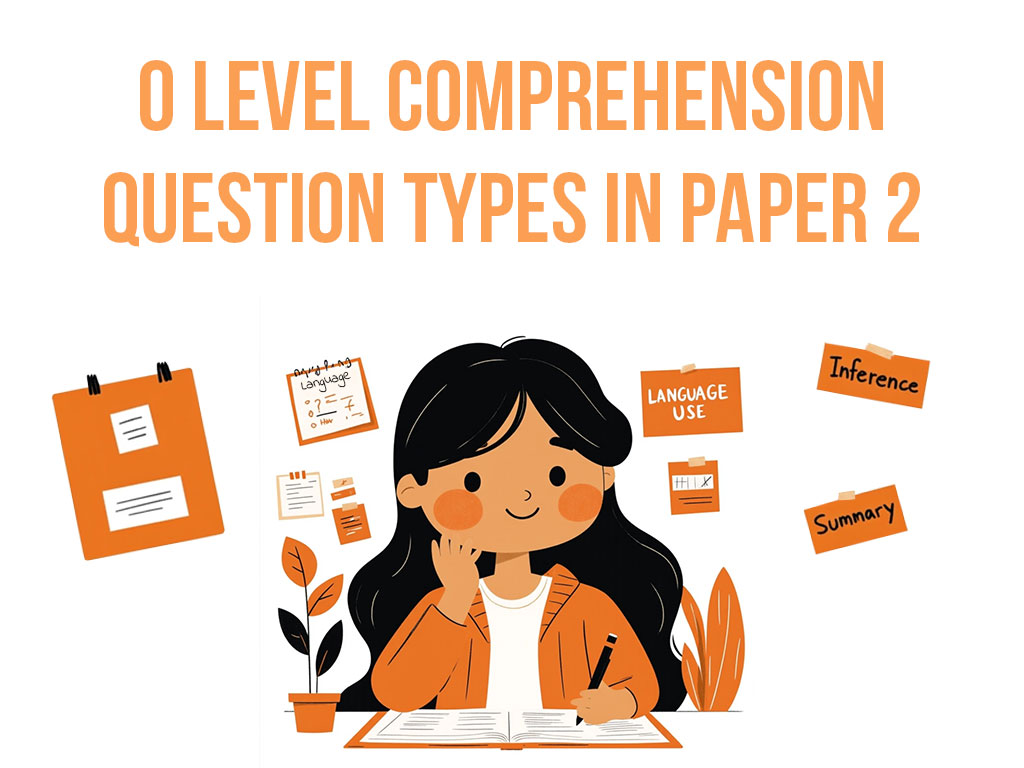O Level English Paper 2 is a significant component of the overall exam, accounting for 50 marks (out of 180) and lasting 1 hour 50 minutes. It tests your comprehension skills by requiring you to analyse a variety of texts, including narratives, visuals, and recounts.
To succeed in Paper 2, you must be familiar with the different types of comprehension questions asked. At Keynote Learning, we’re here to help! Here’s an extensive list of 15 O Level English Comprehension questions you can expect to see in Paper 2.

1. Literal Comprehension Questions
These questions will test a student’s ability to understand and retrieve information that’s stated in written text. Answers are usually straightforward, such as names, dates, places, and events.
Strategies:
2. Vocabulary/Word Meaning Questions
These questions will assess how well students understand specific words or phrases. Often, they’ll need to provide synonyms, define meanings, and determine if a word is used literally or figuratively.
Strategies:
3. Paraphrasing (Own Words) Questions
In this segment, students need to paraphrase a given passage in their own words, demonstrating comprehension of the text without copying.
Strategies:
4. Inferential/Interpretive Questions
These questions ensure that students can read between the lines, make connections, and draw conclusions that are subtle or implied but not explicitly stated. Answers will have to be based on solid reasoning, not guesswork.
Strategies:
5. Figurative Language (Literary Devices) Questions
These focus on identifying and explaining figures of speech such as metaphors, similes, personification, and imagery, showing understanding of both literal and figurative meanings. Explain how each can help to convey meaning, emotion, or mood, and describe its purpose or effect using evidence from the comprehension passages to support your point.
Strategies:
6. Language Use/Effect Questions
These questions require students to explain how language can create impact, and focus on the effectiveness and purpose behind the language used. Answers should illustrate how the text works and why it is effective, not just what they mean.
Strategies:
7. Main Idea Questions
With these questions, students have to identify the primary theme or message of the text, demonstrating a thorough understanding of the overall theme or argument and summarising it accordingly.
Strategies:

Get On-Demand Recap. Anytime, Anywhere.
Keynote Learning students get FREE access to ThinkInn! Enjoy 24/7 access to exclusive in-house video resources and revision materials designed to help you tackle your upcoming O Level English exams.
8. Supporting Details Questions
In this section, students have to pick out examples, factual information, or figures from surrounding sentences in a given passage that support the main point.
Strategies:
9. Cause and Effect Questions
For these questions, students will have to identify the reasons behind outcomes, correctly specifying the relationship between actions and results. Thorough comprehension of the text is required, and logical thinking will ensure the correct answer.
Strategies:
10. Fact vs. Opinion Questions
Students will have to tell the difference between facts and opinions, demonstrating a full understanding of what constitutes each one.
To answer these questions effectively, students should clearly state which it is and why, using evidence from the text.
Strategies:
11. Purpose and Audience Questions
These questions will require students to correctly identify the writer’s intentions and the audience for whom they are writing. Students will also have to determine what the goal of the passage is, for example, to inform, persuade, or entertain.
Strategies:
12. Tone (Author’s Attitude) and Mood Questions
For these questions, students will have to show understanding of the passage’s tone and the writer’s attitude towards the topic. For example, they will have to identify if the tone is funny, happy, sad, or serious, and whether the writer is trying to make the reader feel a specific emotion.
Strategies:
13. Text Structure/Organisation Questions
These questions examine how the text is structured and how it contributes to its overall meaning. For example, students have to explain how paragraphs, headings, and sequencing can affect the flow of information and readability.
Strategies:
14. Summary Questions
Students must show a thorough understanding of the passage, summarising the content in their own words. This will test their understanding and ability to put information into their own words without losing the main points or including any irrelevant details.
Strategies:
15. Personal Response/Evaluation Questions
These questions will ask students for their personal opinions, testing their ability to critically evaluate the ideas and arguments in the passage and make supporting or counterarguments.
Strategies:
Summary of O Level Comprehension Question Types
Question Type | What It Tests | Key Strategies |
|---|---|---|
Literal Comprehension | Ability to find directly stated information in the text. | Scan for keywords; highlight relevant facts; avoid adding interpretation. |
Vocabulary/Word Meaning | Understanding of word meaning and use in context. | Use context clues; check tone; test synonyms; consider connotation. |
Paraphrasing (Own Words) | Ability to restate information in new words. | Identify main idea; use synonyms; restructure clearly; avoid copying. |
Inferential/Interpretive | Understanding of implied meanings and logical conclusions. | Look for clues and implications; connect ideas; justify with evidence. |
Figurative Language | Recognition and analysis of literary devices. | Identify device; explain effect; support with quotes from text. |
Language Use/Effect | Effectiveness of language choices and impact. | Analyse diction and phrasing; link to audience and tone. |
Main Idea | Understanding the central message or theme. | Summarise in one sentence; ignore minor details; find core message. |
Supporting Details | Ability to identify details that support the main idea. | Find facts/examples that support main idea; avoid irrelevant info. |
Cause and Effect | Understanding of causal relationships between ideas. | Spot signal words; link actions and outcomes; support with evidence. |
Fact vs. Opinion | Ability to differentiate objective facts from opinions. | Check for verifiability; look for subjective language; justify clearly. |
Purpose and Audience | Identifying author’s purpose and target audience. | Define goal (inform, persuade, entertain); analyse audience fit. |
Tone and Mood | Recognising emotional tone and mood of the passage. | Identify emotional language; distinguish tone from mood. |
Text Structure/Organisation | Understanding how structure affects meaning and clarity. | Identify text format; note transitions/headings; link to clarity. |
Summary | Summarising key points clearly and concisely. | Focus on essentials; use own words; avoid interpretation. |
Personal Response/Evaluation | Evaluating ideas and expressing a supported opinion. | State personal view; support with passage evidence; evaluate clearly. |
???? Read more: O Level English: How to Prepare for Your 2025 Exams!
Score A1 in English with Keynote Learning!

A strong English score, especially on Paper 2, is crucial for O Level students aiming for their desired school or course.
At Keynote Learning, we meticulously train students to master Paper 2 comprehension techniques using proven answering strategies through our Secondary English Tuition programme, ensuring you are prepared and confident when the all-important exam comes!
What’s more, when you join Keynote Learning, you gain exclusive access to our online resource library (Thinkinn.xyz) where you can get curated in-house O Level English resources and study guides! Get the full Keynote experience and sign up for a trial class today!

